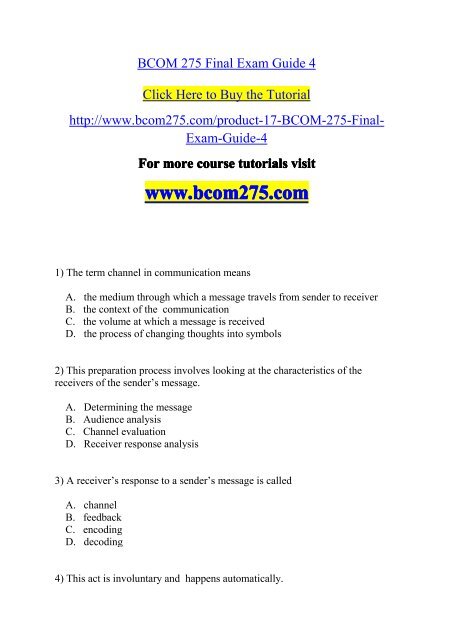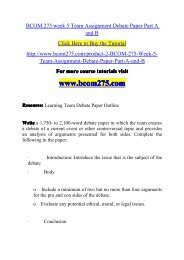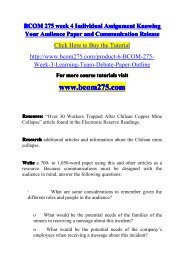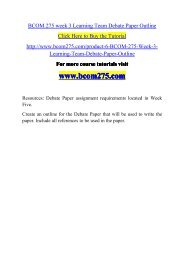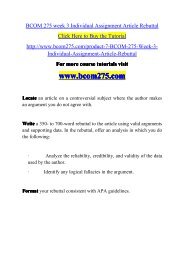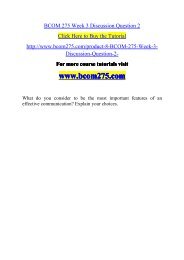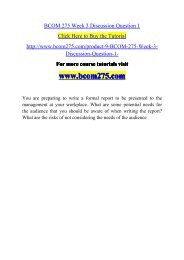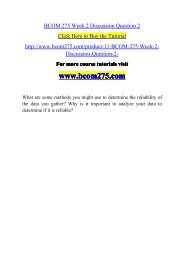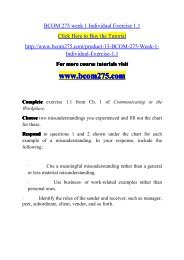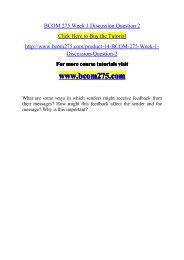BCOM 275 Final Exam Guide 4.-bcom275dotcom
For more course tutorials visit www.bcom275.com 1) The term channel in communication means A. the medium through which a message travels from sender to receiver B. the context of the communication C. the volume at which a message is received D. the process of changing thoughts into symbols 2) This preparation process involves looking at the characteristics of the receivers of the sender’s message. A. Determining the message B. Audience analysis C. Channel evaluation D. Receiver response analysis 3) A receiver’s response to a sender’s message is called A. channel B. feedback C. encoding D. decoding 4) This act is involuntary and happens automatically.
For more course tutorials visit
www.bcom275.com
1) The term channel in communication means
A. the medium through which a message travels from sender to receiver
B. the context of the communication
C. the volume at which a message is received
D. the process of changing thoughts into symbols
2) This preparation process involves looking at the characteristics of the receivers of the sender’s message.
A. Determining the message
B. Audience analysis
C. Channel evaluation
D. Receiver response analysis
3) A receiver’s response to a sender’s message is called
A. channel
B. feedback
C. encoding
D. decoding
4) This act is involuntary and happens automatically.
- No tags were found...
You also want an ePaper? Increase the reach of your titles
YUMPU automatically turns print PDFs into web optimized ePapers that Google loves.
<strong>BCOM</strong> <strong>275</strong> <strong>Final</strong> <strong>Exam</strong> <strong>Guide</strong> 4<br />
Click Here to Buy the Tutorial<br />
http://www.bcom<strong>275</strong>.com/product-17-<strong>BCOM</strong>-<strong>275</strong>-<strong>Final</strong>-<br />
<strong>Exam</strong>-<strong>Guide</strong>-4<br />
For more course tutorials visit<br />
www.bcom<strong>275</strong>.com<br />
1) The term channel in communication means<br />
A. the medium through which a message travels from sender to receiver<br />
B. the context of the communication<br />
C. the volume at which a message is received<br />
D. the process of changing thoughts into symbols<br />
2) This preparation process involves looking at the characteristics of the<br />
receivers of the sender’s message.<br />
A. Determining the message<br />
B. Audience analysis<br />
C. Channel evaluation<br />
D. Receiver response analysis<br />
3) A receiver’s response to a sender’s message is called<br />
A. channel<br />
B. feedback<br />
C. encoding<br />
D. decoding<br />
4) This act is involuntary and happens automatically.
A. Listening<br />
B. Feedback<br />
C. Hearing<br />
D. Responding<br />
5) This happens when you receive, construct meaning from, and respond to the<br />
sender’s message.<br />
A. Responding<br />
B. Attending<br />
C. Listening<br />
D. Hearing<br />
6) With this type of response, you analyze or teach the sender about the cause of<br />
his or her concern.<br />
A. Questioning<br />
B. Interpreting<br />
C. Paraphrasing<br />
D. Evaluating<br />
7) Consider the following exchange: “How do I know God exists? How do you<br />
know he doesn’t?” Which fallacy does the second statement<br />
illustrate?<br />
A. Inconsistency ad hominem<br />
B. Slippery slope<br />
C. Misplacing the burden of proof<br />
D. Perfectionist fallacy<br />
8) Which of the following is a category of reasonless advertising?<br />
A. Endorsement ads<br />
B. Promise ads<br />
C. Functional ads<br />
D. Logical ads
9) A claim is generally not considered credible if<br />
A. it comes from a source assumed to be credible but who is not known to<br />
you<br />
B. the claimant is an interested party<br />
C. the claimant is a disinterested party<br />
D. it seems likely<br />
10) Consider the following statement: “Morgan, you’re down to earth and I trust<br />
your judgment. That’s why I know I can count on you to back me up<br />
at the meeting this afternoon.” This is an example of which fallacy?<br />
A. Argument from pity<br />
B. Slippery slope<br />
C. Guilt trip<br />
D. Apple polishing<br />
11) Providing only two choices when others are available defines which fallacy?<br />
A. Genetic fallacy<br />
B. False dilemma<br />
C. Straw man<br />
D. Ad hominem<br />
12) Stating someone has negative features and his claim is invalid is an example<br />
of which fallacy?<br />
A. Genetic fallacy<br />
B. False dilemma<br />
C. Straw man<br />
D. Ad hominem<br />
13) Audience analysis should occur at what point in the creation of a message?<br />
A. Before the message is sent<br />
B. Once feedback is received<br />
C. After selecting the channel<br />
D. Before the message is created
14) An effective message should be<br />
A. audience-centered<br />
B. topic-based<br />
C. channel-focused<br />
D. time-centered<br />
15) Measurable or observable characteristics of your audience are called<br />
A. psychographics<br />
B. pseudographics<br />
C. statistics<br />
D. demographics<br />
16) Which informal communication channel involves its own abbreviations to<br />
accommodate the limited number of characters available in any given<br />
message?<br />
A. Text message<br />
B. E-mail<br />
C. Handwritten letters<br />
D. Voicemail message<br />
17) Sound and light waves are an example of which part of the communication<br />
model?<br />
A. Encoding<br />
B. Noise<br />
C. Decoding<br />
D. Channel<br />
18) You want to discuss your performance review and possible raise with your<br />
boss. The most effective channel to do this would be<br />
A. e-mail<br />
B. face-to-face
C. team meeting<br />
D. text message<br />
19) When using expert testimonials, speakers should do which of the following?<br />
A. Always quote the expert’s exact words.<br />
B. Share the expert’s credentials.<br />
C. Use experts who have celebrity status.<br />
D. Protect the identity of experts by not naming them.<br />
20) Which verbal support breaks down complex processes or concepts into their<br />
component parts to ensure understanding?<br />
A. Comparisons<br />
B. Analyses<br />
C. Definitions<br />
D. Descriptions<br />
21) What type of language is used when communicating with classmates,<br />
coworkers, family, and friends?<br />
A. Official<br />
B. Informal<br />
C. Ceremonial<br />
D. Formal<br />
22) The connotation of words such as skinny or thin focuses on the<br />
A. actual meaning<br />
B. denotative meaning<br />
C. contextual meaning<br />
D. emotional meaning<br />
23) The individuals you are most likely to influence with your persuasive<br />
presentation are referred to as your<br />
A. peer audience<br />
B. leading audience<br />
C. target audience
D. general audience<br />
24) If you try to persuade your classmates to donate canned goods for the<br />
hungry in your community, your topic is one of<br />
A. policy<br />
B. fact<br />
C. pathos<br />
D. value<br />
25) When you lead, instruct, challenge, or introduce your audience to act on or<br />
accept your solution, you are at which step of Monroe’s Motivated<br />
Sequence?<br />
A. Attention<br />
B. Solution<br />
C. Visualization<br />
D. Action or approval<br />
26) When you display ethos in your persuasive presentation, you have<br />
A. credibility<br />
B. logic<br />
C. emotion<br />
D. evidence<br />
27) What logical fallacy can occur when a speaker focuses on similarities and<br />
ignores significant differences?<br />
A. Either/or thinking<br />
B. Slippery slope<br />
C. Hasty generalization<br />
D. Faulty comparison<br />
28) Groups that value higher power distance believe relationships are<br />
A. individualist<br />
B. relationship oriented<br />
C. hierarchical
D. informal<br />
29) Deliberately blaming individuals or groups for things they really did not do<br />
is called<br />
A. ethnocentrism<br />
B. scapegoating<br />
C. stereotyping<br />
D. discriminating<br />
30) An attempt to characterize causes of events to either personalities or<br />
external situations is called<br />
A. projection<br />
B. halo effect<br />
C. attribution error<br />
D. selective attention<br />
31) The practice of using a case that has already been decided as a guide when<br />
deciding new cases is referred to as<br />
A. legal morality<br />
B. legal paternalism<br />
C. causation principle<br />
D. appeal to precedent<br />
32) A value judgment requires this type of assessment.<br />
A. Worth or desirability<br />
B. Consistency<br />
C. Normative<br />
D. Monroe’s Value Sequence<br />
33) What is the belief that laws are justified if they prevent a person from<br />
harming him- or herself known as?<br />
A. Offense principle<br />
B. Harm principle<br />
C. Legal paternalism<br />
D. Legal moralism


